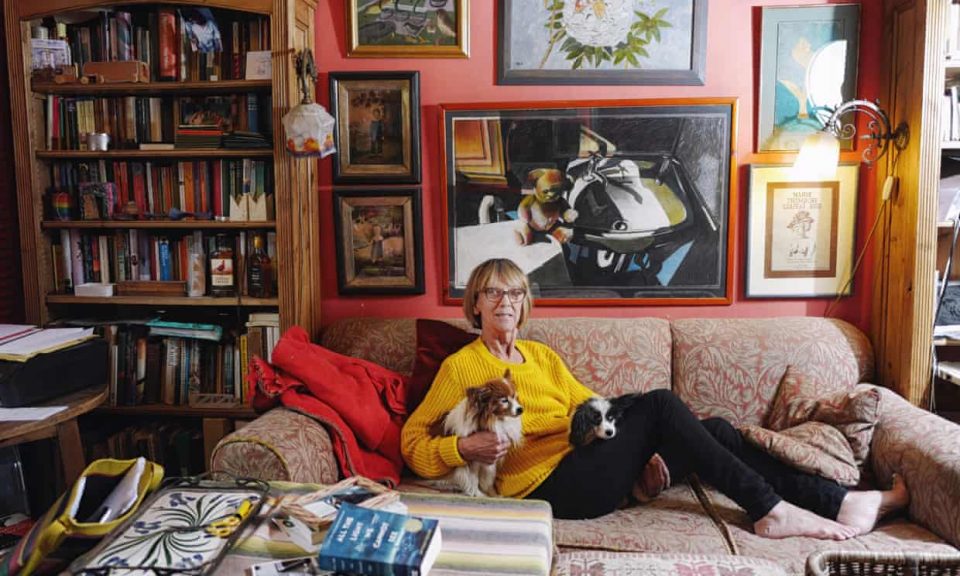In 2004, when her husband, the jazz musician and author [George Melly](https://www.theguardian.com/news/2007/jul/06/guardianobituaries.obituaries), received his diagnoses of dementia and lung cancer, Diana Melly’s brother inquired whether she loved George. Later, upon returning home, she sought the definition of “love” in the dictionary—”to have a deep affection for and significant attachment to; and/or to be in a state of strong emotional and sexual attraction.”
The first part resonated with her current feelings towards George, while the latter pertained to a much earlier time. Throughout her rich, vibrant, and occasionally tumultuous life, Diana, who passed away at 87, experienced love for many individuals in both of these senses—but she acknowledged that her feelings didn’t always unfold in the most appropriate sequence or timing.
Diana was married three times (at ages 16, 20, and 26), experienced two divorces, and had a multitude of romantic relationships outside of these more traditional commitments, with some being lovely but many less so.
Her life during the 1960s mirrored the era’s cinematic portrayal—women boarding planes barefoot amidst an environment laden with marijuana, LSD, kaftans, and sexual liberation. While her “romantic escapades” provided a delightful distraction, they were frequently muddied by less-than-ideal choices and her tendency to prioritize the needs of her romantic partners over those of her three children, each from different marriages.
Her interactions with men reflected the social customs of the time. George and Diana wed in 1963, and during the initial decade of their 45 years together, she dedicated herself to maintaining her appeal to him “to ensure he wouldn’t look elsewhere.” She also made herself necessary, managing his tour schedules, transportation, finances, meals, and the multiple homes they shared, as well as, later on, his complex medication regimen. George affectionately referred to her as Miss Perfect.
Diana’s journey as a writer commenced with a semi-autobiographical novel, *The Girl in the Picture* (1977), arising from her desire to carve out her own identity beyond being known solely as “George’s wife.” Writing soon transformed into an almost compulsive form of self-expression that also provided her with therapeutic relief.
She went on to publish another novel, *The Goosefeather Bed* (1979); a pamphlet titled *I Am a Cypher* (2020), which offered a humorous and self-aware reflection on her emotional and intellectual growth; and two nonfiction works: *Strictly Ballroom: Tales from the Dancefloor* (2015), stemming from her newfound passion for ballroom dancing in her 70s, and a memoir, *Take a Girl Like Me* (2005), which stands out as her most significant contribution.
This memoir is an authentic, humorous, and insightful account, often detailing her role in her occasional misfortunes.
Diana was born in Southampton, Hampshire, the daughter of Geoffrey Dawson, a railway clerk who served in World War II during her early years, and Margaret (née Turnbull), who worked as a cleaner. Following the war, the family relocated to [Essex](https://www.theguardian.com/uk/essex), where Diana attended Colchester girls’ grammar school, leaving at 16 after the headmistress scolded her for “letting the school down” after she was spotted in a stylish local hotel with a soldier.
Her first job was at the Cabaret Club, an upscale and discreet Soho venue, where affluent men mingled with scantily clad women, and where John Profumo would later encounter [Mandy Rice-Davies](https://www.theguardian.com/politics/2014/dec/19/mandy-rice-davies). She earned her keep through tips and Sobranie Black Russian cocktail cigarettes, which she brought home to her mother, who worked as a housekeeper in a grand Hampstead villa, where they lived in modest basement accommodations.
Diana met her first husband, Michael Ashe, at the Cabaret, marrying him in 1954. Eight years later, she would meet George at the Colony Room, another notorious Soho club catering to an artistically inclined crowd (though it occasionally attracted celebrities like [Princess Margaret](https://www.theguardian.com/news/2002/feb/11/guardianobituaries.princessmargaret)). After this, she briefly worked as an assistant at a ladies’ haberdashery in Mayfair, later admitting to pilfering a pair of white gloves from the shop.
In 1971, she began an almost decade-long role at Release, a progressive charity founded by radical feminist and political activist Caroline Coon and her partner [Rufus Harris](https://www.theguardian.com/news/2007/apr/30/guardianobituaries.drugsandalcohol). The organization aimed to aid addicts and advocate for the decriminalization of drugs.
Diana’s responsibilities included ensuring ample teabags were available, working night shifts to take calls from distressed addicts, and securing funds from wealthy donors willing to contribute.
Among her notable accomplishments was obtaining a donation from the Ford Foundation during a 1973 visit to New York, though the charity’s hippie-like “peace’n’love” philosophy sometimes resulted in unconventional donations. The Playboy entrepreneur Victor Lownes, for example, contributed a large golden cast of a penis given to him by his friend, film director Roman Polanski, after they had a falling out. The specifics of how it was monetized remain unknown.
Diana possessed a remarkable ability and desire to organize various aspects of life. Her resourcefulness extended to helping people and nurturing pets, with many furry companions including Tuppy, Franny, and Neko the cats, Bobbie and Joey the Papillon dogs, Danny the guinea pig, Eggs the rabbit, and her most beloved, James Sebastian Fox the fox. Alongside animals, she had many friends to tend to as well.
Among those she cared for was the charming writer [Bruce Chatwin](https://www.theguardian.com/books/2017/sep/24/bruce-chatwin-in-patagonia-fortieth-anniversary), who reached out from the U.S. to ask if he could stay with her at the Tower, their rural retreat in the Brecon Beacons, known for its charmingly dilapidated character. He enticingly offered, “We can both write by day and share the cooking.” His stay turned into nearly five years, during which he produced much of his book *On the Black Hill* in 1982, and apparently never learned to make even a cup of tea.
After Chatwin’s AIDS diagnosis, she devoted herself to caring for him until his passing in 1989. She also assisted the famously sharp-tongued, alcoholic novelist [Jean Rhys](https://www.theguardian.com/books/2022/apr/27/where-to-start-with-jean-rhys), simultaneously serving as her chef and companion, and cared for the bohemian writer and artist [Teddy Millington-Drake](https://www.independent.co.uk/news/people/obituary-teddy-millingtondrake-1448310.html#:~:text=Edgar%20Louis%20Vanderstegen%20Millington%2DDrake,many%20series%20of%20water%2Dcolours). Alongside [Francis Wyndham](https://www.theguardian.com/books/2018/jan/09/francis-wyndham-obituary), she co-edited *Jean Rhys: Letters 1931-1966* (1984).
Upon the release of *Take a Girl Like Me*, it garnered a mix of positive reviews and criticism, with some labeling it “promiscuous, hedonistic, and self-indulgent.” While Diana’s life did tend towards a libertine demeanor, which often led to enjoyable experiences, it also produced challenges.
This lifestyle contributed to tensions in her relationships with her children, and she personally grappling with issues of low self-esteem and depression. Diana faced two failed suicide attempts and two hospitalizations due to nervous breakdowns, one occurring after her oldest child, Patrick, died from a drug overdose. Her daughter, Candy, from her second marriage to sports journalist John Moynihan, also predeceased her.
She noted that she found comfort in the invisible cloak that wraps around most women after they turn 50, navigating the ups and downs of middle age with relative ease. Much of her time was devoted to raising Candy’s daughter, Kezzie, attending to George and listening to Radio 4.
After George’s passing in 2007, she traded Radio 4 for Radio 3 and, at last, began to pursue interests solely for herself. At this stage of her life, she developed an unexpected fascination for physics, algebra, and Greek philosophy, alongside an immense passion for opera, which led her at age 84 to fly economy class across the Atlantic for two performances at the New York Met in just three days.
She is survived by her son Tom and her granddaughter Kezzie.
**Diana Margaret Campion Melly**, writer, born July 26, 1937; died February 2, 2025.


